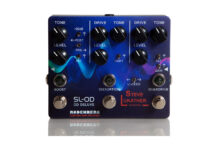This article series is about the tools of popular guitarists. What are their favorite guitars and how is it related to them? This time with Tom Draper & Nate Garrett, the two axemen from „Spirit Adrift“.

When did you start playing the guitar, and do you remember your first guitar?
Tom: I began playing the guitar in January 1997, using an old guitar my dad discovered in the attic. It was a nylon-stringed guitar that, I believe, belonged to my uncle in the 1970s. The action was quite high, making it challenging to play. A few months later, my parents bought me my first electric guitar, a Red Fender Squier Strat with a white scratchplate.
Nate: I began playing guitar at age 13, after 10 miserable years of piano lessons. My first guitar was a Mexican Fender Stratocaster. Black finish with white pick guard, because of Jimi Hendrix. He made me want to play guitar.

Who are your influences, and which guitar players are your favorites?
Tom: I started by learning Britpop and Indie songs from bands like Oasis and Blur. Over time, I expanded into Classic Rock and Heavy Metal, and in recent years, I have developed a keen interest in Jazz Fusion and Funk. Some of my favorite players include Noel Gallagher, Jonny Greenwood, John Squire, James Dean Bradfield, Slash, Angus Young, Neal Schon, Richie Sambora, Kirk Hammett, Adrian Smith, David Gilmour, Ritchie Blackmore, Brian May, Tony Iommi, Michael Amott, Tom Scholz, John Petrucci, Michael Schenker, Gary Moore, Steve Vai, Andy Timmons, Kevin Heybourne, David Andersson, Paul Gilbert, Pete Lesperance, Janne „JB“ Christoffersson, John Sykes, Steve Lukather, Larry Carlton, Masayoshi Takanaka, Tak Matsumoto, George Benson, Bill Steer, Guthrie Govan, Al Di Meola, Tommy Bolin, and Marty Friedman. The list goes on, but these are the ones that come to mind immediately. As for more contemporary guitarists who are currently making waves, I’m a huge fan of Mark Lettieri, Cory Wong, and Tom Misch.
Nate: Early influences were CCR, Skynyrd, and all the stuff I heard on the radio growing up in the south. Old country legends like Waylon Jennings and Merle Haggard, plus FM rock radio like Boston, Tom Petty, Blue Oyster Cult, and that sort of thing. Then I heard Jimi Hendrix and decided I wanted to play guitar. After that, Black Sabbath became my favorite band and still is. They made me want to play even heavier music in a band. That was the gateway to Metallica, Slayer, Thin Lizzy, Priest, Maiden, then more underground heavier stuff like High on Fire, Crowbar, Death, Melvins, Neurosis and stuff like that.
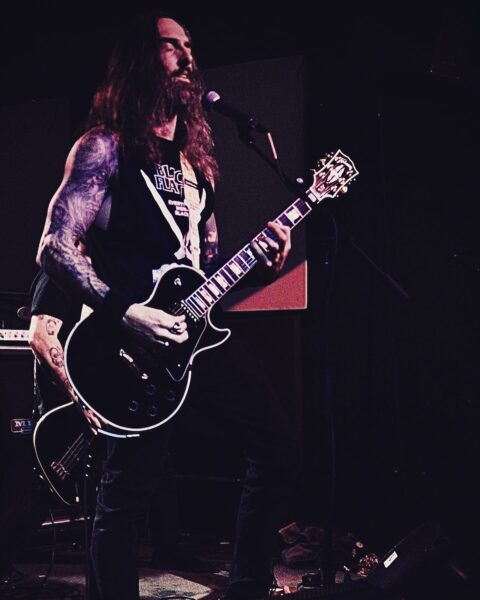
How many guitars do you own, and which models are your favorites?
Tom: I currently own nineteen guitars: seventeen electric, one acoustic, and one bass. Among them, my favorite guitars are the Gibson Les Pauls. I have several of them, including two Customs, two „Custom Lites“ (which are lighter than the regular ones and perfect for live performances), and a 1974 Les Paul Standard that I absolutely adore. I also own a Suhr Modern, which I frequently use for recording, as well as a Strat, a Tele, and a 335…One of my favorite guitars that really stands out is a white 1980s Gibson Explorer equipped with a Floyd Rose tremolo system, a true „shred“ guitar!

Nate: I believe at the moment I own 12 electric guitars and one acoustic guitar, plus a 1979 Fender P Bass that weighs 14 pounds. My favorite guitars are my 1979 Tobacco Burst Les Paul Standard (reminds me of Gary Rossington) and my custom Dunable R2 made of Black Limba, equipped with EMG pickups. My favorite guitar model in general is probably the Les Paul custom, followed by the Dunable R2.
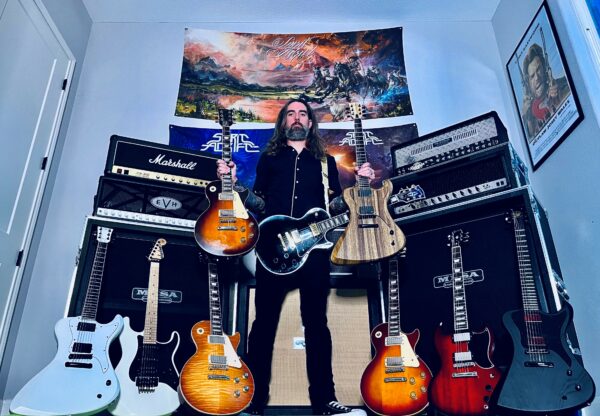
Left to right…Dunable R2 white, Jackson Adrian Smith Signature model, 2020 Gibson Les Paul 60s standard (unburst), 1979 Gibson Les Paul standard (tobacco), 2022 Gibson Les Paul custom, Dunable R2 black limba. 1988 Gibson Les Paul standard (cherry sunburst), 2017 Gibson SG standard, Dunable Nate Garrett signature model
In your opinion, what makes the perfect guitar and amp?
Tom: For me, the perfect combination would be a Gibson Les Paul and a powerful Marshall amp. Due to many of my early influences using this exact setup, I have always been drawn to it, and I feel that it suits my playing style perfectly. I consider myself a rock player with a heavy metal inclination, and the Gibson/Marshall combination is an ideal match for me. In a more general sense, I believe the perfect guitar and amp are whatever feels, sounds, and looks great in the hands of the player.
Nate: A heavy, old Les Paul through an old Marshall. It’s not rocket science. They figured that one out a long time ago and no combination has topped that. I want my sound to be heavy as hell but also have rich harmonics that give the listeners goosebumps.
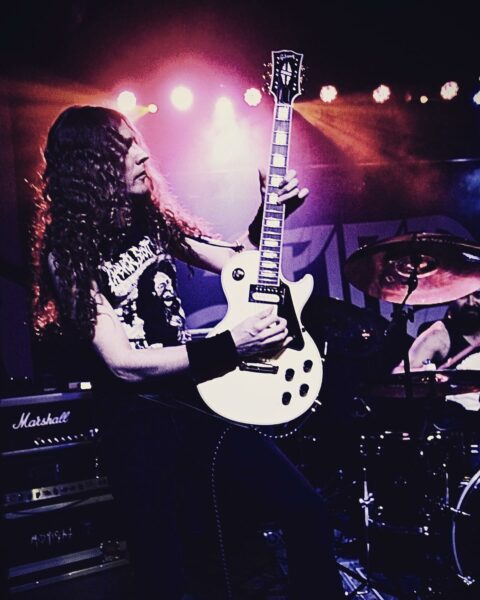
What are your thoughts on the debate between modeler and tube amps?
Tom: I love both options. I own a Kemper, and I think it’s an incredible piece of technology. I’ve profiled a few of my own tube amps on it, and in a recording setting, it’s nearly indistinguishable from the real thing. I appreciate all the built-in effects and the endless number of patches and presets available for download from the internet. It allows ordinary musicians like us to experience what we might sound like through a Dumble or any other typically unattainable amplifier. When it comes to live performances, the choice depends on the setup and the desired vibe and sound of the band. For instance, when playing with Spirit Adrift, where the music calls for cranked tube amps, I prefer throwing a few pedals in front of an amp and turning up the volume. However, if I need more versatility and a range of tones for a gig, with multiple sounds required, I will definitely bring my Kemper. Its versatility and practicality are mind-blowing! Programming different tones and effects, assigning them to the foot controller, and creating setups for each song in a setlist requires some preparation, but the payoff during the actual performance is significant.
Nate: Nothing will ever fully replicate a big, heavy wood guitar through vacuum tubes. You can analyze this scientifically and see without question amp modelers do not produce the same type of sound waves. It’s just not the same. I understand the convenience of amp modelers, plug ins, and all that. But music isn’t about convenience, it’s about making people feel something. And nothing compares to vacuum tubes. Although I will say, my favorite tone for clean guitar does come from the Roland Jazz Chorus, which is solid state.

Which guitars and amps were used for your new album or during recording sessions?
Tom: For most of my lead parts on „Ghost at the Gallows,“ I used my 1974 Gibson Les Paul through a Marshall JCM 800 with a Tube Screamer in front. We experimented with different setups to achieve various tones for different songs. I also believe we used another Gibson guitar that belonged to Jeff (the recording engineer/producer), and we might have utilized an EVH head as well. I also do quite a bit of remote recording at home. In those cases, I plug into my Focusrite Scarlett 2i2 interface and record using Logic Pro X. If the client wants „finished“ tones, I employ a variety of plugins such as Neural DSP and Amplitube, or I re-amp with my Kemper and send back fully printed WAV files. If the client prefers to do the re-amping themselves, I send them direct guitar stems. For home recording, I typically rely on my Suhr Modern guitar. It’s equipped with Doug Aldrich’s signature pickups, which sound incredible. With a 5-way pickup switch and coil-tap feature, it offers a multitude of tonal options. Additionally, it has a reliable tremolo bar, 24 frets, holds its tuning very well and sounds excellent whether clean or dirty. The neck is also very comfortable, which is crucial when recording multiple parts for extended periods.
Nate: We used a ton of different Gibsons. Les Pauls, SG’s, even an old 1970’s Carlos Santana signature guitar that few people know about. Some of the Gibsons were modern, but most of them were from the 70’s. I also used my Jackson Adrian Smith Strat for a solo and a few leads here and there. We used some Dunable guitars as well. We tracked a minimum of 4 rhythm guitar tracks for each song, so we used a ton of combinations of amps as well. These included a 1984 Marshall JCM800, an old JCM900 SLX, Mesa Dual Rec, EVH5150III, Roland Jazz Chorus, and plenty of others.
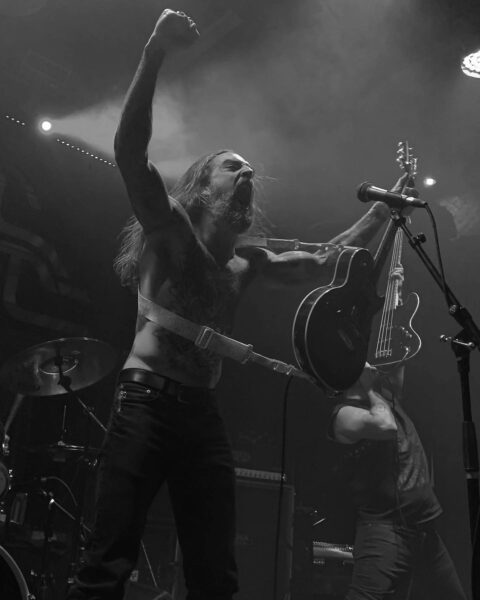
If you could only choose one guitar, which one would you take?
Tom: My white Gibson Les Paul Custom Lite would be my top choice. It looks fantastic, feels and sounds perfect, and at only 8 pounds, it doesn’t strain my back when I play it standing up for extended periods.
Nate: An old Gibson Les Paul. The older and heavier, the better.




